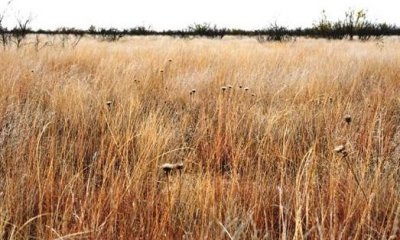
Clay Loam 12-17" PZ
Scenario model
Current ecosystem state
Select a state
Management practices/drivers
Select a transition or restoration pathway
-
Transition T1A
Absence of disturbance and natural regeneration over time, may be coupled with excessive grazing pressure
More details -
Restoration pathway R2A
Adequate rest from defoliation and removal of woody canopy, followed by reintroduction of historic disturbance regimes
More details -
Transition T2A
Absence of disturbance, excessive grazing pressure, and introduction of non-natives
More details -
Restoration pathway R3A
Adequate rest from defoliation and removal of woody canopy, followed by rangeland seeding
More details -
No transition or restoration pathway between the selected states has been described
Target ecosystem state
Select a state
State 1
Grassland State



Description
The Shortgrass/Midgrass Community is the interpretive or "reference" plant community for the Clay Loam Ecological Site. The primary grass species are blue grama (>30 percent) and buffalograss (>20 percent) with lesser amounts of sideoats grama and sand dropseed. Forbs are minimal, less than 5 percent woody plants occur, primarily catclaw mimosa, lotebush, broom snakeweed and an occasional shrubby mesquite. The total production for this plant community ranges from 800 to 2,000 pounds per acre annually.
If grazing pressure occurs for long periods combined with lack of fire, the reference plant community will transition to a Shortgrass/Shrubs Community (1.2). Blue grama and sideoats grama will reach a low vigor state with an increase in perennial and annual forbs. The percentage of bare soil will also increase at this point. Shrubby mesquite will increase to greater than 15 percent canopy. The herbaceous vegetation biomass is still the largest amount of the total site production at this phase, but woody plant production is increasing.
Submodel
Description
In this degraded Shrubland state, typical vegetation will be less palatable shortgrass species; bare areas will open up with annuals filling the voids. Perennial threeawn will invade this site when the more desirable grasses are weakened and/or removed. Scrubby mesquite and broom snakeweed will increase dramatically to the point of domination. The loss of herbaceous cover and increased bare ground encourages accelerated erosion.
Submodel
Description
Clay Loam sites in a weakened state near established areas of Lehman lovegrass may become invaded by this grass to the point that Lehman lovegrass is the dominant grass species in the community. Few if any native grass and forb species will remain. The resulting plant community is a Lehman Lovegrass/Shrub Community (3.1).
Submodel
Mechanism
If heavy grazing pressure continues with no possibility of fire, combined with no brush and pest management, this phase of regression will transition into a shrubland state. The result will be a Shrub/Shortgrass/Annuals Community (2.1).
Mechanism
The plant community is so degraded that it cannot reverse retrogression without extensive energy and management inputs. Restoration of this community (2.1) to the Grassland State (1) will require prescribed grazing with rest periods during the growing season, re-seeding bare areas with adapted native grass species, and heavy mechanical brush management and some form of pest management. With the reduced amounts of grass fuel, prescribed burning is not an option in this phase.
Relevant conservation practices
| Practice | External resources |
|---|---|
|
Brush Management |
|
|
Prescribed Grazing |
|
|
Range Planting |
|
|
Integrated Pest Management (IPM) |
Mechanism
If heavy grazing pressure continues with no possibility of fire, combined with no brush and pest management along with introduced grass invasion of Lehman lovegrass, the Grassland State will transition to the Introduced Grass/Shrubland State (3).
Mechanism
Restoration of this site requires prescribed burning for seedbed preparation purposes may be necessary to remove excessive amounts of plant biomass. Moderate to heavy mechanical brush management, heavy seedbed preparation and re-seeding to a native grass mixture will be required. The application of herbicides can be effective to reduce competition from this lovegrass species, but there is only a narrow time of treatment opportunity. Prescribed grazing and pest management are also required.
Model keys
Briefcase
Add ecological sites and Major Land Resource Areas to your briefcase by clicking on the briefcase (![]() ) icon wherever it occurs. Drag and drop items to reorder. Cookies are used to store briefcase items between browsing sessions. Because of this, the number of items that can be added to your briefcase is limited, and briefcase items added on one device and browser cannot be accessed from another device or browser. Users who do not wish to place cookies on their devices should not use the briefcase tool. Briefcase cookies serve no other purpose than described here and are deleted whenever browsing history is cleared.
) icon wherever it occurs. Drag and drop items to reorder. Cookies are used to store briefcase items between browsing sessions. Because of this, the number of items that can be added to your briefcase is limited, and briefcase items added on one device and browser cannot be accessed from another device or browser. Users who do not wish to place cookies on their devices should not use the briefcase tool. Briefcase cookies serve no other purpose than described here and are deleted whenever browsing history is cleared.
Ecological sites
Major Land Resource Areas
The Ecosystem Dynamics Interpretive Tool is an information system framework developed by the USDA-ARS Jornada Experimental Range, USDA Natural Resources Conservation Service, and New Mexico State University.




